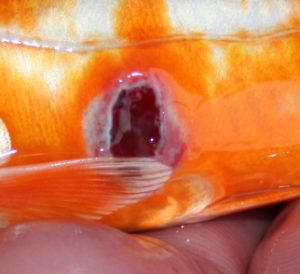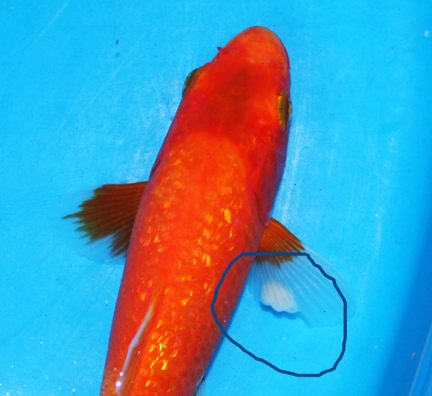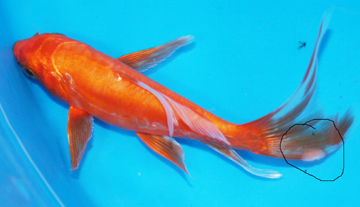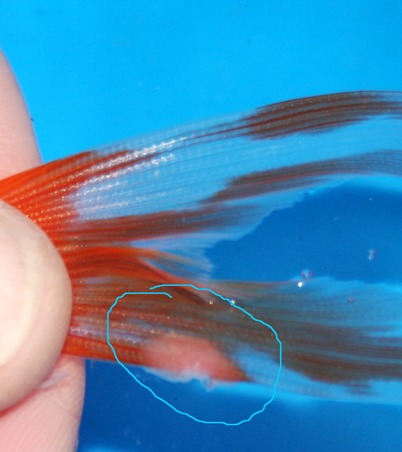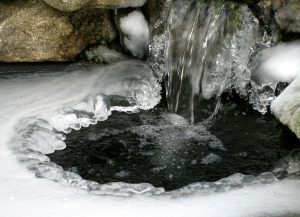Wintertime Health Risks for Koi
Early Detection is Key- What to Look For
If you have Koi, or any fish for that matter, at some point in time you will most likely have some sort of health issue. With the exception of certain viruses, most fish ailments are very curable. The key is to catch any problems in the early stages, be it water quality issues or pathogen issues.
For those of you that live in areas that experience four seasons, it is important you make sure your fish are pathogen free and healthy.It is also critical that the water quality be good as well at this time of year.
The cold itself is a little rough on your fish, so the last thing they need are problems caused by injuries, parasites, and/or water quality issues. This particular article will focus on how to visually inspect your fish to look for symptoms of problems. For further details on common symptoms, refer to my website, and specifically the article entitled “Symptoms of Ill Health in Koi“.
As the winter approaches and the water temps begin to drop, it is at this time that the fishes’ immune systems begin to diminish. The colder it gets, the less their immune systems can protect them. Unfortunately, there is a window of time and temperature that all the pathogens in the pond are still functioning at their peaks. Depending on the individual pathogen, some are still quite active all the way down to 40 degrees Fahrenheit. It is for this reason that you should carefully inspect each fish for signs of problems.
One of the tricks to doing this is simply in how you look at the fish and pond. Do not simply scan the entire pond and fish to look for symptoms. Look at each fish individually and watch them for a short period of time. This time will range from five to ten minutes per fish, depending on how active they are at the time, as well as the water clarity and how well you can see them.
Look for body language signs such as flashing, isolation, fin clamping (be it one or both pectoral fins), abnormal swimming etc. You can get more symptoms from the link above listed in this article. The most important thing is to look at the fish individually. This is the trick to finding even the most subtle signs of problems.
In addition to behavioral and body language symptoms, you should also be looking for signs such as wounds, abnormal marks, red areas or bumps. These can sometimes be low on the side of the fish and hard to see.
The fish below has an ulcer. Can you see it? Notice the slightly raised area as shown by the arrows.
In the first and second photos you can barely see a raised area on the left side of the fish about midway on the body. The third photo is a side view where the problem is easily seen! So as you can see, some issues are very subtle and it takes a trained eye to notice potential problems such as this. In time, you too will be able to spot these subtle issues.
Also, as the water temperatures drop, there are other issues such as carp pox that can suddenly appear on the fish as well. I will address carp pox in another article in this issue.
Meanwhile, below is another example of a problem with a fish that is not easily noticed unless you are looking for it. Both photos are of the same fish. In this particular case, this is an injury that is starting to get infected. If left untreated it could easily end up infected and become a hole in the flesh like the fish above.
Carp Pox- Is it Dangerous?
This is the time of year that water temperatures are dropping in many places. This is also the most common time for something called Carp Pox to start rearing its ugly head as well. I get many calls and emails from folks that see this on their fish and want to know what it is, if it is dangerous, and if it should be treated. I will try to address all this is this article.
Carp Pox is not a pox at all, as the name implies. It is a simply Herpes virus which causes abnormal dermal cell growth and/or neoplasms, very much like that of a wart on a human. No, it is not the same Herpes virus as in KHV ( Koi Herpes Virus/ Cyprinid Herpes Virus 3) that is wiping out many fish around the world. We will discuss that more deadly virus in another article.
Specifically and scientifically, Carp Pox is referred to as Cyprinid Herpes Virus -1 to be exact. It is a harmless aesthetic problem that is very common to Koi. It is very much temperature related, as most times it only shows itself in colder water temps or dropping water temps, only to disappear later as the water warms again.
The most common way it appears is as white to pink lumps on fins, tails, or bodies of the Koi. Sometimes as well you will see spider capillaries in the area as well that are feeding a blood supply to the lesions.
As this is a virus, it can be contagious. However, I have found that that is not a real threat in most average situations, at least not to the degree that it is worth isolating that fish from the rest of them you may have in the same tank or pond. However, the likelihood of it spreading increases as the fish load increases, and as the organic load of the system they are housed in increases. In other words, if your pond or tanks are very crowded with fish, or extremely dirty, then it can more easily spread due to the increased degree of physical contact between fish.
It is most commonly seen on the fins and tail, but as stated above it can also appear anywhere on the body. Also as stated, in most cases it will only appear in cold water, and usually goes away as the water warms in the spring and summer months. It can, however, come and go at any time of the year, and in any temperatures.
Most times a given fish with this problem will only have it come and go for a season or two. After that, it many times will go away forever. There are the rare cases of fish that get these lesions all over their bodies, and they never go away, and increase in numbers over time. In these cases, I would isolate that fish from the rest of the population, or even consider getting rid of it. These cases are very rare as stated however. In these rare cases, and even normal cases, there is some speculation that it is brought about due to environmental conditions either in the form of pollutants or simply dirty high organic load systems. No one knows for sure.
I do not recommend that you attempt to remove these lesions, as you could cause more damage than good. In some cases they can easily be removed, however, with little to no damage to the fish. If you do attempt to remove the lesions, I would then isolate the fish. The reason for this is that when removing them, you could easily cause many of the viral particles to be released into the system and more easily affect any other fish in situ with the affected one. Also if you do attempt to remove them, I would topically treat the area with iodine to prevent infection from setting in.
Personally, I would just leave them alone and see if they went away on their own as quite often they do. Below are some more examples of what these lesions can look like on the fish.
Prepping Your Pond for Winter
For those of you that live in areas with four seasons, I am sure you know how tough the extreme cold can be on our Koi. I get asked all of the time if it is better to keep waterfalls and/or pumps running or shut them down. Well, I am afraid there is no one answer to that question, as there are a few variables involved that change the answer from pond to pond. In this article, I will attempt to address the most common variables and winter dangers to consider, and how to better create or attempt to create optimal conditions.
Let me first say to those of you that do not already know, that you must not feed your fish in the winter once the water gets down to 50 Degrees F. You can read more details in another article in this issue.
Now, let’s talk about the other issues that cold water may bring our fish. The two other primary issues that come into play in cold water are the actual water temperatures and something called hydrogen sulfide poisoning.
Let’s start with water temperatures. Fish during the colder temperatures are in what is called a state of torpor. During this time the fishes immune systems are practically non-existent. This in itself can leave them very vulnerable to health issues. That is why it is critical to maintain perfect water quality all winter long and to also make sure that the fish are going into winter with no other issues like pathogens/parasites.
Koi are considered temperate water fish, as opposed to tropical or coldwater which means Koi can tolerate the colder water temperatures, but it is not an optimal environment for them to thrive. Even more specifically, once the water temperatures go down to 40 degrees and lower, this is especially hard for them. So as you can see, it is important to try and keep the water temperatures from getting below the 40 degree mark. However, this is not always an easy thing to do for most folks.
There is also another factor referred to as “super cooling” of the water. Some folks say this is a myth, but I totally disagree. Super cooling is when the water temperatures can actually go below freezing. That’s right, I said below freezing. This sounds impossible, as most folks know that water freezes at 32 degrees. How is this possible then for the water itself to get below this temperature? Here is how this can happen.
Many folks have waterfalls and/or streams that feed their ponds. If these are running in the wintertime during very cold weather, this can cause this super cooling effect. Let’s say the outside air temperature on a given winter day is 20 degrees F. As the waterfall or streams flow , they push the water through the open air at these low temperatures. As this happens, it acts like a cooling tower or radiator, and the water can possible be pushed to these lower air temperatures as the air cools the water. In other words, as the water flows through the 20 degree air, the air will cool the water with a similar affect as blowing on hot soup to cool it down. In most cases, the amount of time the water comes into contact with the air is not sufficient enough to cool the water down to match a low air temp like 20 DF, but theoretically it is possible. The speed of the flow also dictates just how much the water gets cooled. Either way, this action of water passing through colder air will absolutely lower the water temperature to some extent, and we do not want to do that if possible.
Even though this action can only be controlled to a certain degree, there are some things we can do to detour super cooling from happening, or at least make it more difficult. I personally shut down my pumps during the colder times in winter. However, my plumbing, pond depth, and pond design can accommodate this action. Most average ponds and pond designs cannot withstand this without the plumbing freezing and causing major issues. So do not attempt this if you are not sure.
As an example, my plumbing is buried deep enough that with no flow, and even with water trapped in the buried pipes and such, these areas will not freeze because they are insulated by the depth of the earth they are buried in. As stated, most peoples’ plumbing systems are not designed this way and therefore cannot be left turned off with water inside the pipes and other plumbing. Also in my situation, any plumbing that is above ground is also protected in some fashion from freezing. Things like heat tape and insulation are just a couple ways I do this.
Another important consideration is the depth of the pond. Logically the deeper the water, the less affected it will be by changes in the outside air temperatures. Therefore, the deeper the water, the more stable it will be, and this is also important to our fish. If your water has major temperature swings of ten degrees or more in a day, this can really be hard on them. Even five degree swings from warm to cold can have detrimental affects. So as you can see, we need to find ways to tweak things to keep this from happening, or at least not promote its occurrence.
As previously mentioned, unfortunately most average hobbyists have shallow ponds of less than three feet in depth. Basically put, the water on the bottom of the pond will be as cold as the surface water or very close to it. As a matter of fact, anything less than six feet in depth is also subject to this. Once water gets deeper than six feet, thermoclines can form. These are simply layers of varied temperatures. As an example in a pond of six feet in depth on a given winter day, the bottom up to two feet may be 40 degrees, and from two feet to the surface may be 38 degrees. That two degree difference can really help the fish. No matter the depth or the temperature of the water in winter, Koi will always stay in whatever depth is the most stable and/or the warmest. This will generally be on the very bottom in most cases.
Now understanding that they need stability and warmth, you must think of ways to tweak your systems to better accommodate the fish. For example, those of you that have submersible pumps sitting on the very bottom of the pond should consider moving them more towards the surface. More exact is to get them away from the bottom. With the pump on the bottom, and especially pumping to streams and waterfalls, you are transferring the water to the surface where it will get further chilled by the outside air temperature. So, even though your situation may force you to keep the pumps running in winter, at least move it as far as feasible from the bottom of the pond. Since the fish will be spending all their time on the bottom in winter, we want to keep that area as warm as possible and with as little current as possible in these situations. Current is actually good for the fish to a degree, but not if you have a shallow pond less than six feet deep. Leave the bottom as undisturbed as possible.
Another way to tweak things is to install a simple ball valve on the discharge side of you pump. Make sure you put it where you can get to it easily. In winter, you can simply close the valve partially to slow the whole system down as much as possible. This will also help lessen super cooling affects, as well as slowing any excessive current on the bottom depending on what type and where your return water enters. Personally, I have these valves on every system on the farm, as it gives you some flexibility with flow rates. There are other times when you may want to slow the flow as well, be it wintertime or not.
In general, when it comes to water temperature, you simply want to do all you can feasibly do to help keep the fish as comfortable as possible and keep the water as stable as possible. Some folks even go to to the extent of erecting make-shift greenhouses over the ponds. This can easily be done with a PVC pipe frame and semi-clear plastic. You can also suspend a 100 watt light inside of it and make it even warmer. Also keep in mind that when a pond freezes over, the ice itself can act like a greenhouse. So for this reason the fish can actually be more comfortable in the colder areas where this occurs. However, there are some other dangers involved in a pond that freezes over. We will discuss those next.
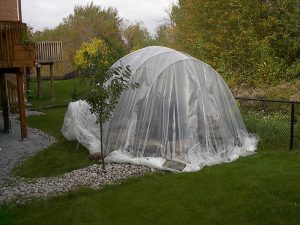
In areas where the surface of the pond freezes, it is critical to keep a hole in the ice. The reason for this is to let dangerous gases escape that are created in the pond by decaying organic matter. The primary culprit and the reason that many fish get killed each winter is from hydrogen sulfide poisoning.
As stated, hydrogen sulfide is a gas that is naturally occurring in every pond. Primarily it comes from the decaying of any organic material in the pond. Things like leaves, fish waste, dead bugs, pine needles, and anything of an organic nature will break down into this lethal gas. This occurs in every pond and in every season. In the warmer months it is not an issue, however, because the gas simply escapes out the surface of the pond. In winter, however, when the ponds freeze over these gases cannot escape through the surface due to the blanket of ice covering the pond. If this happens it will poison the water, and thus poison your fish. More detailed is it affects their gills and kills them. Many, many ponds have been wiped out by this occurrence. For this reason it is critical to keep a hole in the ice for these gases to escape freely.
There have been many times that I have discussed keeping a hole in the ice with people that did not know, only to have them reply that their pond has frozen over before with no issues or deaths. Let me say emphatically, “they were very lucky”!
Most likely the reason they got away with it had to do with the physical size of their fish and their overall fish load. This is the number of fish combined with the size of each fish. As stated, hydrogen sulfide affects the fishes’ gills. Well, the smaller the fish, the smaller the gill surface area, and thus the more likely they can survive. Simply put, each year your fish load changes. This is due to fish growing and/or the addition of new fish. As the fish grow, the danger increases with their larger gill surface area. At some point as they grow, and/or the fish load changes, this gas will kill them. It is simply a matter of when it kills them, and not if kills them! Some folks have ignored this advice because they have had no prior issues with the pond freezing. Let me say this: every one of those people has come back to the farm to purchase new fish because they killed them this way.
So, as you can see, it is critical to keep a hole in the ice. This can be done with commercially made pond de-icers/heaters, pumps, or air stones. You can purchase some of these right from my website.
I personally use two separate ways to achieve the hole. I use a 200 watt floating heater, in addition to an airstone hanging just below the heater. The airstone puts out bubbles which help keep a hole open as well. In this way, if one fails for whatever reason, I have the other as a backup. As stated, you can also use a small water pump installed near the surface in a way to circulate the water just under or at the surface. This movement will also keep a hole. Another consideration is to install these devices directly over where the fish hang in the pond in winter. This can be critical for those of you that have long ponds, say 30 feet or more. If the fish sit on the bottom at one end, and the hole is in the surface at the other, the gases cannot escape efficiently enough sometimes. Try to put the devices on the surface and directly over the fish. This will usually be the deepest section of the pond.
In summary, try your best to keep the pond 40 degrees or higher, and make sure to maintain a hole in the ice if the pond freezes over. It is critical as well to periodically check the pond to make sure that the hole is still there. It sometimes can take only one day of being frozen over to kill all the fish if the device failed for some reason.
Written by John Fornaro, Copyright Hanover Koi Farms LLC 2017


